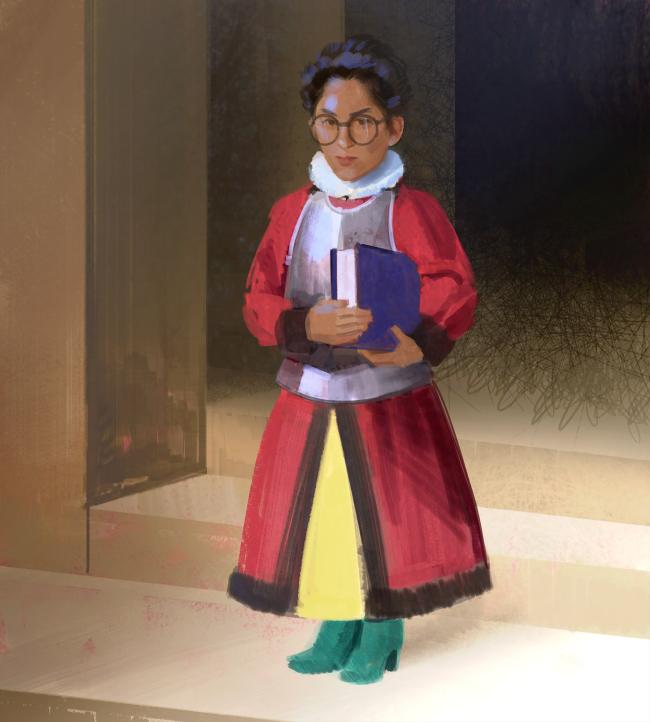
AC 10
HP 11 (2d8 + 2; bloodied 5)
Speed 30 ft.
Proficiency +2; Maneuver DC 10
Skills Medicine +4, Religion +2 (+1d4)
Senses passive Perception 12
Languages any one
Spellcasting. The acolyte is a 2nd level spellcaster. Their spellcasting ability is Wisdom (spell save DC 12, +4 to hit with spell attacks). They have the following cleric spells prepared:
Cantrips (at will): light , sacred flame , thaumaturgy
1st-level (3 slots): bless , cure wounds , sanctuary
ACTIONS
Club. Melee Weapon Attack: +2 to hit, reach 5 ft., one target. Hit: 2 (1d4) bludgeoning damage.
Sacred Flame (Cantrip; V, S). One creature the acolyte can see within 60 feet makes a DC 12 Dexterity saving throw , taking 4 (1d8) radiant damage on a failure. This spell ignores cover .
Bless (1st-Level; V, S, M, Concentration). Up to three creatures within 30 feet add a d4 to attack rolls and saving throws for 1 minute.
Cure Wounds (1st-Level; V, S). The acolyte touches a willing living creature, restoring 6 (1d8 + 2) hit points to it.
An acolyte is a priest in training or an assistant to a more senior member of the clergy. While acolytes may be found acting as servants or messengers in major temples, an acolyte may also be the only representative of their faith serving a village or roadside shrine.
CR 0–2 1d4 acolytes ; priest ; warhordling orc eye ; trickster priest ; acolyte with 1d4 commoners
Treasure 10 gp, silver ring etched with holy symbol (25 gp), 3 potions of healing
CR 3–4 2 priests ; priest with 1d4 acolytes ; priest with 1d8 commoners or 1d4 guards ; warhordling orc eye with 1d4 warhordling orc warriors ; trickster priest with cutthroat or 1d6 bandits
Treasure 50 gp, fine vestments (100 gp), 3 prayer books (25 gp each), staff of the python
CR 5–10 high priest with 1d8 acolytes , 1d6 cultists , or 2 priests ; high priest with bearded devil , air elemental , earth elemental , fire elemental , water elemental , knight , or walking statue ; priest with 2 knights or 1d8 soldiers ; shadow elf high priest with 1d8 shadow elf warriors
Treasure 200 gp, garnet-topped staff (150 gp), 3 rare holy books (200 gp each), 2 potions of superior healing , pearl of power
CR 11–16 archpriest ; high priest with holy knight and 4 soldiers ; high priest with bone devil , clay guardian , deva , or forgotten god ; shadow elf high priest with shadow elf champion warrior and 1d20 shadow elf warriors
Treasure gold-plated treasure box (200 gp) containing 1,000 gp and 4 tourmaline gemstones (100 gp each), gold holy symbol (250 gp), 2 spell scrolls of greater restoration , ring of protection
CR 17–22 archpriest with couatl , elemental , or holy knight ; archpriest with 2 knights or priests ; shadow elf high priest with shadow elf mage and 1 or 2 shadow elf champion warriors
Treasure 500 pp, only existing copy of a holy book (5,000 gp), spell scrolls of create undead or conjure celestial , candle of invocation , staff of healing
CR 23–30 archpriest with holy knight and 3 knights ; archpriest with high priest and 3 priests ; archpriest with clay guardian , deva , or guardian naga
Treasure 2,000 gp, gold chalice (2,500 gp), gold-and-diamond holy symbol (7,500 gp), gem prayer beads (10,000 gp), holy relic (10,000 gp), 2 potions of supreme healing , Ioun stone of insight , ring of spell turning
Humanoids include a number of different intelligent, language-using bipeds of Small or Medium size. Humans and elves are humanoids, and so are orcs and goblins. Humanoids may employ magic but are not fundamentally magical—a characteristic that distinguishes them from bipedal, language-using fey, fiends, and other monsters. Humanoids have no inherent alignment, meaning that no humanoid ancestry is naturally good or evil, lawful or chaotic.
